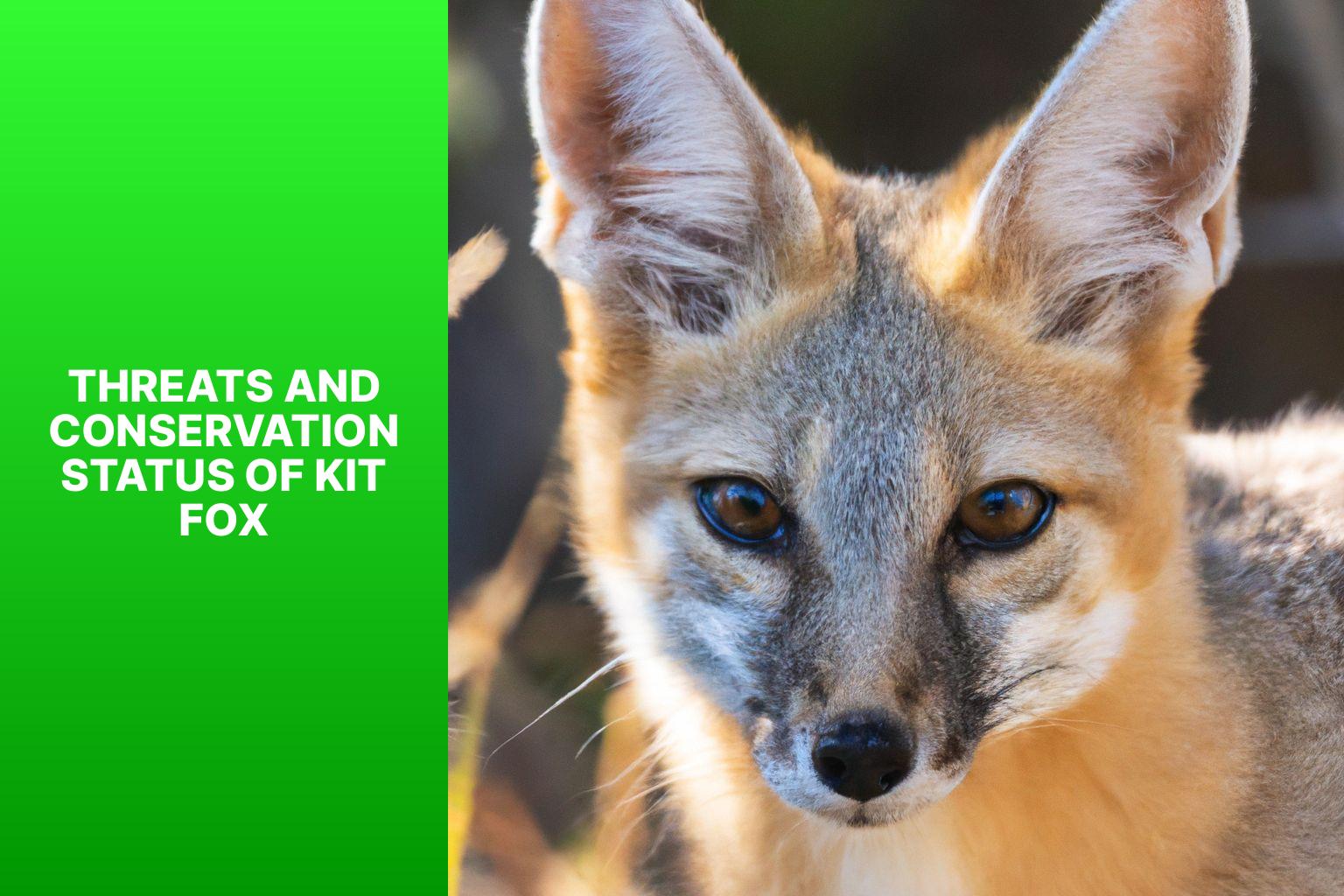The Kit Fox is a fascinating species that thrives in various habitats across its range. With its unique physical and behavioral characteristics, this small canid has adapted to survive in diverse environments. In this article, we will explore the physiology of the Kit Fox and delve into its adaptations for desert living, nocturnal hunting, and survival in harsh environments. we will discuss the threats the Kit Fox faces and its conservation status. By gaining a deeper understanding of this remarkable animal, we can appreciate its important role in maintaining the ecological balance of its habitat. Let’s explore the impact of climate change on Kit Fox populations and uncover the secrets of its physiology.
Contents
- 1 Key takeaway:
- 2 Physical and Behavioral Characteristics of Kit Fox
- 3 Habitat and Range of Kit Fox
- 4 Diet and Feeding Habits of Kit Fox
- 5 Reproduction and Life Cycle of Kit Fox
- 6 Adaptations of Kit Fox in Animal Physiology
- 7 Threats and Conservation Status of Kit Fox
- 8 Frequently Asked Questions
- 8.1 What is the kit fox’s unique foraging behavior?
- 8.2 How were the energy and water intake rates of the kit fox measured?
- 8.3 What were the findings regarding the field cost of activity in the kit fox?
- 8.4 Did the field cost of activity in the kit fox vary with the season?
- 8.5 What is the significance of activity energy expenditure for kit foxes during nonreproductive seasons?
- 8.6 Where are kit foxes primarily found and what are their ecological roles?
Key takeaway:
- Kit Foxes have physical characteristics that enable them to thrive in their environment: With their compact size, slender body, large ears, and bushy tail, Kit Foxes are well-adapted for survival in the desert regions they inhabit. Their behavior also includes specific characteristics suited to their survival needs.
- The Kit Fox’s habitat and range are limited: Kit Foxes are primarily found in the southwestern United States and northern Mexico. They inhabit desert and semi-arid regions, often making their dens in underground burrows or abandoned dens of other animals.
- Kit Foxes have specialized adaptations for survival: In order to cope with the extreme heat and arid conditions of the desert, Kit Foxes have physiological adaptations such as efficient water conservation mechanisms and the ability to tolerate high temperatures. They also possess adaptations for nocturnal hunting and navigating their harsh environments.
Physical and Behavioral Characteristics of Kit Fox
With their distinctive physical and behavioral attributes, Kit Foxes enchant and captivate onlookers. Delve into their world as we explore the unique characteristics that make them truly remarkable. From their physical traits that enable them to thrive in challenging environments, to their fascinating behaviors that demonstrate their incredible adaptability, this section unveils the mesmerizing world of the Kit Fox.
Physical Characteristics
Here is a table summarizing the physical characteristics of the Kit Fox:
| Physical Characteristics | Description |
|---|---|
| Size | The Kit Fox measures about 1.5 to 2 feet in length. |
| Weight | An adult Kit Fox weighs between 3 to 6 pounds. |
| Appearance | The Kit Fox has a slender body with a black-tipped tail. Its fur is typically gray or buff-colored, with a whitish underbelly. |
| Ears | Kit Foxes have relatively large ears, which assist them in thermal regulation. |
| Eyes | Their eyes are usually golden or amber in color, providing excellent night vision. |
| Adaptations | The Kit Fox has keen senses, sharp teeth, and retractable claws for climbing and digging. |
The physical characteristics of the Kit Fox make it well-suited to its desert habitat. Its small size and lightweight allow it to navigate through narrow crevices and burrows. The large ears help dissipate heat, while the keen senses and night vision aid in hunting at night. The Kit Fox’s appearance, with its gray or buff-colored fur, provides camouflage in its arid surroundings.
A true story that showcases the physical characteristics of the Kit Fox involves a researcher studying their behavior in the deserts of North America. The researcher observed a Kit Fox effortlessly squeezing through a small opening in a rock formation to reach its den. The fox’s lightweight and slim body allowed it to navigate the narrow passage with ease. This observation highlighted the Kit Fox’s remarkable physical adaptations that enable it to thrive in harsh desert environments.
Behavioral Characteristics
Kit foxes exhibit various behavioral characteristics that allow them to adapt and survive in their natural habitat. One notable aspect of their behavior is their social behavior. While they are often solitary animals, kit foxes are also capable of forming small family groups. They communicate with each other through vocalizations, body postures, and scent marking, which help them establish and maintain social bonds.
Another important behavioral characteristic of kit foxes is their nocturnal activity. These foxes are primarily active during the night, taking advantage of their exceptional night vision and sensitive hearing. These adaptations enable them to hunt and navigate successfully in low-light conditions.
Territorial behavior is also prominent among kit foxes. They vigorously defend their territories from other foxes and mark their boundaries with scent markings. When necessary, they may even engage in aggressive behaviors to protect their space and resources.
In terms of hunting and feeding, kit foxes display opportunistic behavior. They are skilled hunters and feed on a wide range of prey, including small mammals, birds, insects, and fruits. Their excellent hearing and hunting skills aid them in locating and capturing their food efficiently.
Burrowing behavior is another distinctive trait of kit foxes. They are adept diggers and create burrows in sandy or soft soil. These burrows serve multiple functions, serving as shelters that protect them from extreme temperatures and predators.
To truly appreciate the behavioral characteristics of kit foxes, it is essential to observe them in their natural habitat without causing any disturbance to their routines. By observing their interactions and behaviors, one can gain a deeper understanding of these fascinating creatures.
Habitat and Range of Kit Fox

Photo Credits: Foxauthority.Com by Ralph Adams
The kit fox (Vulpes macrotis) is a species of small fox that is commonly found in North America. It is known to inhabit a range of habitats in the southwestern United States and northern Mexico.
The kit fox is typically found in arid regions, such as deserts and grasslands. It has the ability to adapt to different types of landscapes, including sand dunes, rocky terrain, and open plains. It can also be observed in agricultural and suburban areas that are situated near its natural habitat.
The range of the kit fox extends from southern Oregon and Idaho all the way to central Mexico. It tends to prefer areas that have an abundant supply of prey, such as rodents and small mammals. Access to water sources is also a crucial factor for the survival of this species in the dry regions it inhabits.
These foxes are social animals and they form small family groups. They build burrows in the ground, which serve as protection against extreme temperatures and predators. These burrows can be quite intricate, with multiple entrances and chambers.
There are ongoing efforts to protect the kit fox and its habitat. The loss of habitat due to urbanization and agriculture has had a negative impact on the population of these foxes. Therefore, it is essential to preserve their natural habitat and minimize conflicts with humans in order to safeguard this unique desert species.
Diet and Feeding Habits of Kit Fox
The diet and feeding habits of the kit fox are truly fascinating and are vital for its survival. These clever creatures primarily consume small mammals such as kangaroo rats and mice, displaying their excellent hunting skills and acute hearing which allows them to locate prey even underground. They also consume insects, birds, reptiles, and occasionally indulge in fruits and vegetation.
Kit foxes are known for their agility and speed as hunters. Their slender bodies and long legs enable them to excavate burrows and capture their prey effectively. In times of necessity, they scavenge for food, making use of carcasses abandoned by larger predators.
The feeding habits of kit foxes are greatly influenced by their surroundings and availability of food. As nocturnal animals, they are most active during the night. This nocturnal behavior helps them to avoid extreme temperatures, potential threats from predators, and take full advantage of the abundance of small mammals that are similarly active at night.
When encountering kit foxes in the wild, it is essential to maintain a respectful distance and refrain from disturbing their feeding or hunting activities. Instead, observing them from a distance provides valuable insights into their natural behavior and ultimately contributes to their conservation efforts.
Reproduction and Life Cycle of Kit Fox

Photo Credits: Foxauthority.Com by Eugene Nguyen
Reproduction and Life Cycle of Kit Fox
The Kit Fox follows a specific pattern for reproduction and life cycle. Here are the key details:
- Mating: Kit Foxes have a monogamous mating system. A male and female form a pair bond for life. Mating occurs in late winter or early spring.
- Gestation: After mating, the female Kit Fox undergoes a 50-day gestation period.
- Litter Size: The female Kit Fox gives birth to 2 to 7 pups. The average litter size is around 4 to 5 pups.
- Parental Care: Both the male and female Kit Fox actively participate in raising their young. They take turns hunting for food and providing care to the pups.
- Weaning: The pups are usually weaned at 6 to 8 weeks of age. During this time, they start consuming solid food and gradually become independent.
- Dispersal: Young Kit Foxes begin to disperse from their natal territory at around 6 months of age to establish their own home ranges.
- Sexual Maturity: Kit Foxes reach sexual maturity at around one year of age, although some may mature earlier.
- Life Span: Kit Foxes generally live for about 4 to 6 years in the wild. They have been known to live up to 12 years in captivity.
Understanding the reproduction and life cycle of the Kit Fox provides valuable insights into their behavior and population dynamics. It is a fascinating process that contributes to the survival and continuity of this remarkable species.
Adaptations of Kit Fox in Animal Physiology

Photo Credits: Foxauthority.Com by Mark Taylor
The Kit Fox, known for its remarkable adaptations, exhibits a range of captivating physiological traits. From its ability to thrive in the desert to its exceptional nocturnal hunting skills, and even its survival strategies in harsh environments, the Kit Fox offers a fascinating study in animal physiology. Get ready to discover the extraordinary ways in which this species has adapted to its unique challenges and environments.
Adaptations for Desert Living
The Kit Fox is well equipped with adaptations for desert living. It possesses various characteristics that allow it to thrive in this harsh environment.
One of these adaptations is its large ears, which help dissipate heat and regulate its body temperature.
The Kit Fox is primarily nocturnal, avoiding the extreme heat of the day and conserving energy.
It is also a skilled digger, creating burrow systems for shelter and protection.
To conserve water, the Kit Fox obtains moisture from its food.
Its thick fur provides insulation and protection from the sun, while its sandy coat acts as effective camouflage.
Despite limited resources, such as small rodents, insects, and plant matter, the Kit Fox is able to survive in desert environments.
These adaptations make the Kit Fox highly efficient and successful in desert ecosystems.
Through unique physiological and behavioral traits, it has evolved to thrive in these challenging conditions.
Adaptations for Nocturnal Hunting
Adaptations for nocturnal hunting are vital for the survival and success of kit foxes. These adaptations allow them to effectively navigate and hunt in low light conditions.
1. Enhanced night vision: Kit foxes possess large eyes specifically adapted for night vision. Their enlarged pupils enable more light to enter their eyes, while the tapetum lucidum, a reflective layer situated behind the retina, enhances their ability to see in dim light. This gives them a significant advantage when hunting in darkness.
2. Acute hearing: Kit foxes have highly sensitive ears that can detect even the slightest sounds, enabling them to locate their prey. Their large ears also help dissipate excess body heat, allowing them to stay cool during the night.
3. Specialized hunting techniques: Kit foxes employ stealth and patience in their hunting strategies. They utilize stalking techniques, silently and slowly approaching their prey before pouncing with precision. Their sharp teeth and claws assist in securing and immobilizing their catch.
4. Adapted diet: Kit foxes have evolved to consume a diverse range of nocturnal prey, including small mammals, insects, birds, and reptiles. This flexible diet allows them to take advantage of available food sources at night.
True story: One night in the desert, a kit fox embarked on a nocturnal adventure, utilizing its keen senses and cunning hunting skills. It silently trotted through the sandy terrain, its large ears alert for any sound. Suddenly, it detected a rustle in the underbrush. With lightning speed, the kit fox sprang into action, swiftly capturing a scurrying mouse. Once again, its adaptations for nocturnal hunting had proven invaluable, ensuring its survival in the harsh desert environment. The kit fox continued its journey under the starlit sky, exemplifying the resilience and resourcefulness of a creature perfectly adapted for the night.
Adaptations for Survival in Harsh Environments
When it comes to survival in harsh environments, the kit fox has developed several adaptations. These adaptations include:
-
Efficient body temperature regulation: The kit fox has a low surface area-to-volume ratio, minimizing heat loss in cold environments and reducing heat gain in hot environments.
-
Water conservation: In harsh desert environments with scarce water, the kit fox obtains water solely from its food, reducing the need for external sources.
-
Digging burrows: The kit fox is an expert digger, using sharp claws to create burrows. These burrows provide protection from predators and extreme weather conditions, offering a safe and stable environment.
-
Adapted diet: The kit fox has a diverse diet including small mammals, insects, reptiles, and fruits. This versatility allows it to survive when certain food sources are scarce.
-
Nocturnal behavior: Kit foxes are primarily nocturnal, avoiding intense daytime heat and reducing water loss through evaporation.
-
Enhanced hearing and vision: Kit foxes have acute hearing and excellent night vision to navigate challenging environments. These adaptations help them detect prey, avoid predators, and find their way in low-light conditions.
Threats and Conservation Status of Kit Fox

Photo Credits: Foxauthority.Com by Brandon Adams
The conservation status of the kit fox is at risk due to various threats, including habitat loss, urban development, agricultural expansion, and climate change.
One major concern for kit foxes is habitat loss. Human activities, such as urban development and agricultural expansion, destroy or fragment their natural habitats in deserts and grasslands. This limits their ability to find food and shelter.
Urban development poses another threat to kit foxes. As cities and towns expand, they encroach on kit fox habitats, leading to increased competition for resources and higher mortality rates due to vehicle collisions and predation by domestic animals.
Agricultural activities, including crop cultivation and pesticide use, impact the kit fox population as well. Pesticides can harm foxes directly or contaminate their prey, leading to reduced food availability and reproductive success.
Climate change also affects kit foxes. Rising temperatures and changing precipitation patterns can alter their habitat and food sources. Extreme weather events like droughts and wildfires can further impact their survival.
To protect the kit fox population, it is important to focus on habitat preservation, establish protected areas, practice responsible land management, and raise awareness about the significance of kit fox conservation. Prioritizing the conservation of this species is crucial for their long-term survival.
Frequently Asked Questions
What is the kit fox’s unique foraging behavior?
The kit fox is almost exclusively carnivorous and reportedly independent of drinking water.
How were the energy and water intake rates of the kit fox measured?
The measurements of energy and water intake rates were made using the doubly labeled water technique, combined with behavioral observations and diet analyses.
What were the findings regarding the field cost of activity in the kit fox?
The study found that kit foxes traveled long distances, with males typically traveling farther than females. Daily movement distances were influenced by the season, with males traveling the greatest distances in spring and females traveling the farthest in summer. The field cost of activity per unit distance was estimated as 15.6 kJ km(-1) using a multiple linear regression model.
Did the field cost of activity in the kit fox vary with the season?
Surprisingly, the field cost of activity was not affected by season, despite the expectation of higher costs in the winter due to increased thermoregulatory expenditure.
What is the significance of activity energy expenditure for kit foxes during nonreproductive seasons?
Activity energy expenditure accounted for a significant portion of the foxes’ field metabolic rate during nonreproductive seasons, with foxes expending 11%-33% of their field metabolic rate in activity, with a mean of 21%.
Where are kit foxes primarily found and what are their ecological roles?
Kit foxes are primarily found in the southwestern part of the United States and northern and central Mexico. They are important members of native ecosystems, helping to control rodent populations through predation and contributing to biodegradation.


